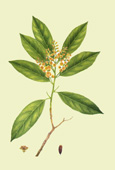| Latin Name | Symplocos racemosa Roxb. (Symplocaceae) |
| English Name | Lodh tree |
| Sanskrit Names | Lodhra, Tilva, Shavara |
| Hindi Name | Lodh |
 History: This tree, in Sanskrit, is called Lodhra, Rodhra or Srimata meaning "propitious", and "Tilaka" because it is used in making the Tilaka mark on the forehead. A decoction of the bark is used as a gargle when the gums are spongy and bleeding (Susruta). Roxburgh remarks that the bark is in request among the dyes of red in Calcutta and seems to be used as a mordant only. In Europe it was formerly looked upon as a cinchona bark and has been known at various times as "Ecorce de lautour", "China nova", "China calafornica", "China Brasilarsis", and "China paraquatan". It is also known as "Lotus Bark". Distribution: Abundant in the plains and lower hills throughout North and East India, ascending in the Himalayas up to an elevation of 1,400 m; southwards it extends up to Chota Nagpur. Habit: S.r. is an evergreen tree or shrub. The leaves are dark green above, orbicular, elliptic oblong, coriaceous and glabrous above; the flowers are white, turning yellow, fragrant, in axillary, simple or compound racemes; the drupes are purplish black, subcylindric, smooth and 1-3 seeded. Principle constituents: Three alkaloids, viz. loturine, loturidine and colloturine. Indications: The astringent bark is given for the treatment of diarrhea, dysentery and liver complaints. It is recommended in the treatment of menorrhagia and other uterine disorders. Product range: Diarex, EveCare |
|